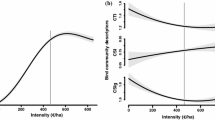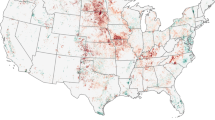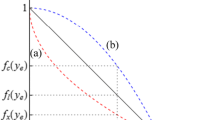Abstract
Intensive agriculture is often bad for wildlife. Does this imply that a goal to boost wildlife on agricultural land is best met through a general reduction in intensity? We argue that such an approach may not be optimal, since cost functions for provision of wildlife on agricultural land may be non-convex, due to fixed costs associated with such provision. This implies that, even when farms are identical, it may be preferable to split them into groups of high providers and low providers. We test our hypothesis in a study of the optimal management of mown grasslands in southern Sweden, where the two products are silage and successful reproduction of ground-nesting birds, and the variable controlled by the farmer is the date of the first mowing. We show that the optimal solution is likely to involve some farmers maintaining profit-maximizing practices while other—identical—farmers delay their first mowing significantly. The superiority of such split solutions may have major implications for agricultural policy.





Similar content being viewed by others
Notes
Due to the context-dependence of the relationship between biodiversity and agriculture we focus on one region alone. In further work it would be interesting to extend the analysis to other regions.
According to the EU’s General Budget for Agriculture and Rural Development, direct payments totalled €39 billion in 2010.
Note that \(n\) may be \(0\) or greater.
Note that equivalent results are obtained by assuming a positive price of nature \(\lambda _z\).
Recall Proposition 5, and note that given a fixed cost of nature production the cost function for nature production must lie above \(f(z)\) for sufficiently low levels of nature production.
Note that breeding time is thus \(t-U\).
To show that the second derivative is positive note that
$$\begin{aligned} \frac{{\mathrm{d}}^2 c}{{\mathrm{d}}z^2} = \frac{{\mathrm{d}}({\mathrm{d}}c / {\mathrm{d}}z)}{{\mathrm{d}}t}\Big / \frac{{\mathrm{d}}z}{{\mathrm{d}}t}, \end{aligned}$$and show that each of the factors in the RHS are positive.
Note also that spatial aspects are also relevant to the sparing–sharing dilemma. If land potentially used for production of both food and nature is non-homogeneous then the relevance of spatial aspects is obvious; however, even when land is homogeneous the spatial arrangement of nature oases given a split solution is likely to be important. Consider for instance the debate concerning green corridors, see e.g. Simberloff et al. (1992).
References
Benton T, Vickery J, Wilson J (2003) Farmland biodiversity: is habitat heterogeneity the key? Trends Ecol Evol 18:182–188
Billeter R, Liira J, Bailey D, Bugter R, Arens P, Augenstein I, Aviron S, Baudry J, Bukacek R, Burel F, Cerny M, De Blust G, De Cock R, Diekotter T, Dietz H, Dirksen J, Dormann C, Durka W, Frenzel M, Hamersky R, Hendrickx F, Herzog F, Klotz S, Koolstra B, Lausch A, Le Coeur D, Maelfait JP, Opdam P, Roubalova M, Schermann A, Schermann N, Schmidt T, Schweiger O, Smulders MJM, Speelmans M, Simova P, Verboom J, van Wingerden WKRE, Zobel M, Edwards PJ (2008) Indicators for biodiversity in agricultural landscapes: a pan-European study. J Appl Ecol 45(1):141–150
Brady M, Kellermann K, Sahrbacher C, Jelinek L (2009) Impacts of decoupled agricultural support on farm structure, biodiversity and landscape mosaic: some EU results. J Agric Econ 60(3):563–585
Broyer J (2003) Unmown refuge areas and their influence on the survival of grassland birds in the Saone valley (France). Biodivers Conserv 12:1219–1237
Broyer J (2009) Whinchat Saxicola rubetra reproductive success according to hay cutting schedule and meadow passerine density in alluvial and upland meadows in France. J Nat Conserv 17(3):160–167
Clough Y, Barkmann J, Juhrbandt J, Kessler M, Wanger TC, Anshary A, Buchori D, Cicuzza D, Darras K, Putra DD, Erasmi S, Pitopang R, Schmidt C, Schulze CH, Seidel D, Steffan-Dewenter I, Stenchly K, Vidal S, Weist M, Wielgoss AC, Tscharntke T (2011) Combining high biodiversity with high yields in tropical agroforests. Proc Natl Acad Sci 108:8311–8316
COM (2011) Proposal for a regulation of the European parliament and of the council establishing rules for direct payments to farmers under support schemes within the framework of the common agricultural policy. 2011/0280, European Commission, Brussels
Daan S, Dijkstra C, Tinbergen JM (1990) Family-planning in the kestrel (falco-tinnunculus)—the ultimate control of covariation of laying date and clutch size. Behaviour 114:83–116
Donald PF, Green RE, Heath MF (2001) Agricultural intensification and the collapse of Europe’s farmland bird populations. Proc R Soc Lond B Biol Sci 268(1462):25–29
Donald PF, Sanderson FJ, Burfield IJ, van Bommel FPJ (2006) Further evidence of continent-wide impacts of agricultural intensification on European farmland birds, 1990–2000. Agric Ecosyst Environ 116(3–4):189–196
Drent RH (2006) The timing of birds’ breeding seasons: the Perrins hypothesis revisited especially for migrants. ARDEA 94(3):305–322
Edwards PJ, Kollmann J, Wood D (1999) The agroecosystem in the landscape: implications for biodiversity and ecosystem function. In: Wood D, Lenné JM (eds) Agrobiodiversity: characterization, utilization and management. CAB International, Wallingford, UK, pp 183–210
Egan JF, Mortensen DA (2012) A comparison of land-sharing and land-sparing strategies for plant richness conservation in agricultural landscapes. Ecol Appl 22(2):459–471
EU (2011) Cap reform—an explanation of the main elements. MEMO/11/685
Green R, Tyler G, Stowe T, Newton A (1997) A simulation model of the effect of mowing of agricultural grassland on the breeding success of the corncrake (Crex crex). J Zool 243:81–115
Green RE, Cornell SJ, Scharlemann JPW, Balmford A (2005) Farming and the fate of wild nature. Science 307(5709):550–555
Grubler M, Schuler H, Muller M, Spaar R, Horch P, Naef-Daenzer B (2008) Female biased mortality caused by anthropogenic nest loss contributes to population decline and adult sex ratio of a meadow bird. Biol Conserv 141:3040–3049
Gunnarsson C, Vagstrom L, Hansson P (2008) Logistics for forage harvest to biogas production-timeliness, capacities and costs in a Swedish case study. Biomass Bioenergy 32(12):1263–1273
Gunnarsson C, Sporndly R, Rosenqvist H, de Toro A, Hansson P (2009) A method of estimating timeliness costs in forage harvesting illustrated using harvesting systems in sweden. Grass Forage Sci 64(3):276–291
Gutiérrez-Vélez VH, DeFries R, Pinedo-Vásquez M, Uriarte M, Padoch C, Baethgen W, Fernandes K, Lim Y (2011) High-yield oil palm expansion spares land at the expense of forests in the peruvian amazon. Environ Res Lett 6(4):044,029
Hodgson JA, Kunin WE, Thomas CD, Benton TG, Gabriel D (2010) Comparing organic farming and land sparing: optimizing yield and butterfly populations at a landscape scale. Ecol Lett 13(11):1358–1367
Humbert J, Ghazoul J, Walter T (2009) Meadow harvesting techniques and their impacts on field fauna. Agric Ecosyst Environ 130:1–8
Kleijn D, Sutherland WJ (2003) How effective are European agri-environment schemes in conserving and promoting biodiversity? J Appl Ecol 40(6):947–969
Kleijn D, Baquero R, Clough Y, Diaz M, De Esteban J, Fernandez F, Gabriel D, Herzog F, Holzschuh A, Johl R, Knop E, Kruess A, Marshall E, Steffan-Dewenter I, Tscharntke T, Verhulst J, West T, Yela J (2006) Mixed biodiversity benefits of agri-environment schemes in five European countries. Ecol Lett 9:243–254
Kleijn D, Kohler F, Baldi A, Batary P, Concepcion ED, Clough Y, Diaz M, Gabriel D, Holzschuh A, Knop E, Kovacs A, Marshall EJP, Tscharntke T, Verhulst J (2009) On the relationship between farmland biodiversity and land-use intensity in europe. Proc R Soc Lond B Biol Sci 276(1658):903–909
Kleijn D, Rundlöf M, Scheper J, Smith HG, Tscharntke T (2011) Does conservation on farmland contribute to halting the biodiversity decline? Trends Ecol Evol 26(9):474–481
Lindborg R, Bengtsson J, Berg A, Cousins SAO, Eriksson O, Gustafsson T, Hasund KP, Lenoir L, Pihlgren A, Sjodin E, Stenseke M (2008) A landscape perspective on conservation of semi-natural grasslands. Agric Ecosyst Environ 125(1–4):213–222
Nocera J, Parsons G, Milton G, Fredeen A (2005) Compatibility of delayed cutting regime with bird breeding and hay nutritional quality. Agric Ecosyst Environ 107:245–253
Perrins CM (1965) Population fluctuations and clutch-size in the great tit, Parus major L. J Animal Ecol 34(3):601–647
Perrins CM, McCleery RH (1989) Laying dates and clutch size in the great tit. Wilson Bull 101(2):236–253
Phalan B, Onial M, Balmford A, Green RE (2011) Reconciling food production and biodiversity conservation: land sharing and land sparing compared. Science 333(6047):1289–1291
Phelps J (2007) Much ado about decoupling: evaluating the environmental impact of recent European Union agricultural reform. Harvard Environ Law Rev 31:279–320
Rauscher M, Barbier EB (2010) Biodiversity and geography. Resour Energy Econ 32(2):241–260
Roodbergen M, Klok C (2008) Timing of breeding and reproductive output in two black-tailed godwit limosa limosa populations in the Netherlands. Ardea 96:219–232
Sanchirico JN, Wilen JE (1999) Bioeconomics of spatial exploitation in a patchy environment. J Environ Econ Manag 37(2):129–150
Simberloff D, Farr JA, Cox J, Mehlman DW (1992) Movement corridors: conservation bargains or poor investments? Conserv Biol 6(4):493–504
Smith R, Jones L (1991) The phenology of mesotrophic grassland in the Pennine Dales, northern England—Historic hay cutting dates, vegetation variation and plant-species phenologies. J Appl Ecol 28:42–59
Stoate C, Baldi A, Beja P, Boatman ND, Herzon I, van Doorn A, de Snoo GR, Rakosy L, Ramwell C (2009) Ecological impacts of early 21st century agricultural change in Europe: a review. J Environ Manag 91(1):22–46
Tyler G, Green R, Casey C (1998) Survival and behaviour of corncrake crex crex chicks during the mowing of agricultural grassland. Bird Study 45:35–50
Vickery JA, Tallowin JR, Feber RE, Asteraki EJ, Atkinson PW, Fuller RJ, Brown VK (2001) The management of lowland neutral grasslands in Britain: effects of agricultural practices on birds and their food resources. J Appl Ecol 38(3):647–664
Author information
Authors and Affiliations
Corresponding author
Additional information
We thank Henrik Smith, Johan Ekroos, Jan Clough and Sören Höjgård for valuable discussions on the land sharing–sparing dilemma. OO and MB were partly financed by two grants from FORMAS, ‘More biodiversity at less cost’ to OO and ‘SAPES’ to Henrik Smith.
Rights and permissions
About this article
Cite this article
Hart, R., Brady, M. & Olsson, O. Joint Production of Food and Wildlife: Uniform Measures or Nature Oases?. Environ Resource Econ 59, 187–205 (2014). https://doi.org/10.1007/s10640-013-9723-2
Accepted:
Published:
Issue Date:
DOI: https://doi.org/10.1007/s10640-013-9723-2




